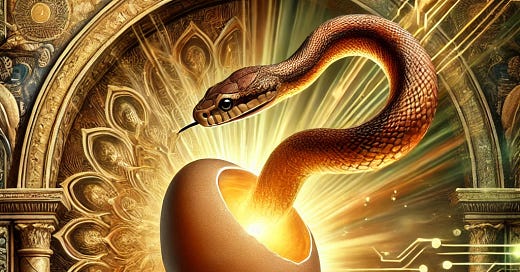9 Signs We're Entering a Renaissance Like We've Never Seen Before
...this one is planetary, multidimensional, and unfolding at unprecedented speed.
We are living in a pressure cooker of change. Just as the Black Death was followed by the European Renaissance, today's global crises—climate change, digital transformation, institutional collapse, and a mass spiritual awakening—are setting the stage for a new era of rebirth. But unlike past renaissances confined to specific regions or classes, this one is planetary, multidimensional, and unfolding at unprecedented speed.
Here are 9 powerful indicators that we are entering a Renaissance unlike any before:
1. Humanism and the Rise of Individual Empowerment
Renaissance humanism placed emphasis on human potential, intellectual exploration, and individual creativity. Today, the self-development movement, digital nomadism, and the rise of personal branding reflect a similar shift. People are reclaiming their agency, questioning old paradigms, and seeking fulfillment beyond traditional societal roles. The spiritual awakening happening worldwide mirrors the Renaissance-era shift from rigid dogma to personal exploration of meaning.
2. Artistic and Technological Innovation
During the Renaissance, the mastery of perspective and realism in art led to the creation of iconic works. Today, we see a parallel in the AI revolution—tools like MidJourney, open ai, and AI-generated filmmaking are transforming creative expression. Just as the printing press once democratized information, digital technology and AI are empowering a new wave of independent creators, allowing anyone to produce, publish, and share their work globally.
3. Scientific Advancements and New Paradigms
The Renaissance saw Copernicus challenging the geocentric model and Galileo pioneering modern physics. Today, quantum physics, plasma research, biohacking, and space colonization push the boundaries of human understanding. The James Webb Telescope gives us a deeper look into the cosmos, while breakthroughs in consciousness studies, such as HeartMath and psychedelics for mental health, are redefining our understanding of reality itself.
4. Shifts in Philosophy and Spirituality
The Renaissance moved away from purely religious explanations of the world, embracing philosophical and esoteric thought. Similarly, our era is seeing a decline in rigid institutional beliefs and a rise in alternative spirituality, holistic wellness, and interdisciplinary philosophies that integrate science with mysticism. The renewed interest in ancient wisdom—such as Egyptian, Hermetic, and Kabbalistic traditions—mirrors the Renaissance fascination with rediscovering lost knowledge.
5. A New Literary and Linguistic Explosion
Just as Renaissance writers like Shakespeare and Dante revolutionized storytelling, we are witnessing a new era of expression. Platforms like X (formerly Twitter), Substack, and independent publishing are fueling a decentralized literary movement. Authors, philosophers, and content creators are reaching global audiences without relying on traditional gatekeepers, much like the Renaissance-era shift from Latin to vernacular languages made knowledge more accessible.
6. Architectural and Urban Revival
Classical Renaissance architecture emphasized harmony and proportion. Today, we see a return to sustainable and human-centric design—biophilic architecture, smart cities, and eco-friendly spaces designed to nurture both people and the planet. Instead of just replicating the past, modern architects are merging technology with nature, much like Renaissance builders blended ancient principles with new engineering techniques.
7. Economic Transformations and Decentralization
The Renaissance was driven by the rise of merchant classes and banking innovations. Our time is marked by similar economic disruptions—cryptocurrency, decentralized finance (DeFi), and the gig economy are reshaping wealth distribution. Just as Florence thrived under the patronage of the Medici, modern venture capitalists, crowdfunding, and decentralized organizations are funding today’s innovators outside of traditional institutions.
8. The Information and Knowledge Revolution
Gutenberg’s printing press ignited the spread of knowledge, much like the internet and blockchain do today. Open-source education, online courses, and AI-driven research are breaking barriers to learning, making knowledge freely available to all. This democratization of information is fueling a new age of enlightenment, where truth is no longer monopolized by a select few.
9. Esoteric Knowledge and Mysticism
Renaissance thinkers explored astrology, alchemy, and Hermeticism alongside science. Today, there is a resurgence of interest in ancient wisdom—manifestation practices, sacred geometry, and energetic healing. The modern renaissance is not just technological but deeply spiritual, integrating the mystical with the scientific in ways that past generations resisted. Each previous golden age defined by humans journey inside consciousness itself.
The Birth of a New World
As in all renaissances, periods of transformation are accompanied by upheaval. Just as the Black Death preceded the European Renaissance, today’s crises—climate change, economic uncertainty, and the breakdown of old institutions—are forcing humanity to innovate and evolve. What emerges from this will be a new way of living, creating, and understanding our place in the cosmos.
We are not merely living in the digital age; we are at the dawn of a new Renaissance—one that merges science and spirituality, decentralization and creativity, technology and timeless wisdom. Just as the past renaissances shaped the course of history, so too will this modern rebirth define the future of humanity. The question is, how will you contribute to this unfolding renaissance? Who will play Michelangelo?





